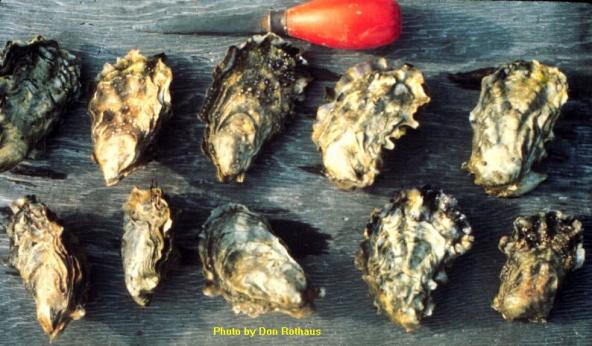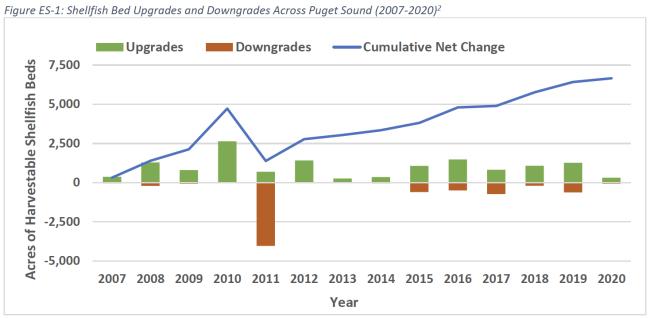Regional perspectives on the effectiveness of Puget Sound shellfish recovery actions
A 2021 report commissioned by the Washington State Department of Natural Resources identifies potential actions at the state or local level, or in combination, that could further bolster shellfish bed recovery in support of the Puget Sound Partnership's shellfish bed recovery target.

Executive Summary
Project Overview
To support Puget Sound Partnership (PSP) Priority Science Work Actions identified in its 2016-18 Science Work Plan, the Washington State Department of Natural Resources (DNR) contracted with Ross Strategic to 1) capture regional perceptions of the effectiveness of recovery and long-term protection efforts intended to restore Puget Sound shellfish beds to harvestable condition and 2) develop recommendations to enhance regional shellfish recovery action effectiveness based on interview data. [Download the full report.]
Commercial and recreational shellfish harvest is an important part of Puget Sound’s culture and economy and multiple organizations and agencies, led and coordinated by the Washington State Department of Health, devote significant resources to maintaining harvestable acres and restoring areas that are closed due to water quality issues. Since 2007, 13,838 acres of harvestable shellfish beds were upgraded and 7,179 acres downgraded, a net increase of 6,659 acres (Figure ES-1). Of Puget Sound’s approximately 257,000 acres of classified commercial and recreational shellfish beds, around 33,000 acres, or 13%, do not meet water quality standards and are closed to harvest. Given the demonstrated success of existing programs, this report identifies additional potential actions at the state or local level, or in combination, that could bolster shellfish bed recovery and achieve further positive gains, in support of PSP’s shellfish bed recovery target.1 Actions were identified based on interviews mainly with shellfish protection experts in local and tribal jurisdictions and guided by a project steering committee which included local, tribal, and state agency representatives.
Figure ES-1: Shellfish Bed Upgrades and Downgrades Across Puget Sound (2007-2020)2
Shellfish protection programs in Puget Sound are governed by multiple local and state agencies which operate under various regulatory regimes; these agencies also manage and implement voluntary and incentive-based programs designed to improve shellfish bed health. Funding for these programs comes from numerous sources including local government, state agencies, and federal agencies; some funding is built into county tax structures; other funding is grant-based. This report focuses on three aspects of shellfish bed recovery programs, each of which are explored below and in depth in the full report:
- Role and effectiveness of Shellfish Protection Districts (SPDs)
- Water quality regulations, enforcement, and lean opportunities as they pertain to shellfish growing areas3
- Shellfish protection program data types, needs, and sources
To understand the shellfish bed protection and recovery landscape, develop case studies, identify shellfish protection program barriers and challenges, and develop recommendations, the project team conducted desk research and collected qualitative data through approximately twenty semi-structured, one-hour interviews with regional shellfish recovery program staff. Note: Interviews included pollution identification and correction (PIC) program staff and county-level staff tasked with implementing closure response plans for specific SPDs. Because of the overlap between PIC programs and SPDs, some findings are specific to SPDs, while other findings are applicable to PIC programs.
Shellfish Protection Districts: Key Takeaways
SPD effectiveness depends on many factors, including environmental conditions, types of nonpoint pollution sources in the area, political support for staff, amount of funding available for programmatic needs, and staff capacity to communicate and coordinate with key partners. Local political and economic conditions vary among counties and there is no “typical” SPD in Puget Sound. However, conversations with SPD staff (interviewees) revealed best practices and successes in various areas, challenges for program staff, and opportunities to improve effectiveness through aligning multiple stakeholder activities that target shellfish bed protection.
Shellfish Growing Area Regulations and Enforcement: Key Takeaways
Many organizations, programs, and regulations affect Washington’s recreational and commercial shellfish harvest areas through their responsibilities to protect and maintain water quality. Washington State Department of Health (DOH) is the state’s Shellfish Control Authority;4 it classifies commercial shellfish growing areas and publicly owned recreational shellfish harvesting beaches based on water quality and current and potential pollution sources. Other state agencies, local government health jurisdictions, and counties regulate and enforce key factors that drive shellfish area classification, including stormwater, on-site sewage systems, wastewater treatment plants and marinas, and animal waste management on farms. Coordination within and between organizations involved in shellfish bed health was a central theme in findings related to challenges and barriers, as well as recommendations. As with any complex system, coordination among key components is a significant contributing factor to success.
Data Collection and Use: Key Takeaways
High quality data is one of the cornerstones of an effective shellfish protection program. State agencies and local jurisdictions use data to 1) identify water quality status and trends, 2) identify pollution sources, and 3) support outreach and enforcement efforts. Data collection, analysis, and use varies widely across shellfish protection programs depending on various factors within the jurisdictions such as funding availability, staffing, and program maturity. Although funding is a significant challenge for local programs as they collect and analyze water quality in connection with shellfish bed health, there are opportunities to gain efficiencies and share best practices. Some of these opportunities are found at the local level while others are under state agencies purview.
Case Studies
The project team developed two short case studies to illustrate approaches that local jurisdictions are taking to address the challenges and barriers associated with implementing activities aimed at protecting and recovering shellfish beds: 1) Jefferson County Foundational Monitoring Project and 2) Hood Canal Regional Pollution Identification and Correction (PIC) Program. The Jefferson County example illustrates a local jurisdiction approach to data collection while the Hood Canal example illustrates a regional approach to information sharing and cross-jurisdictional project coordination. The project team selected the case studies by analyzing initial interview data for examples, conducting further online research for background where available, and then following up with interviewees (and contacts suggested by these interviewees) for additional detail.
Conclusion and Potential Future Work
Shellfish protection in Puget Sound is the result of longstanding, well-developed, nested state and local programs and is largely successful as measured by the positive change in open shellfish growing areas. The findings and recommendations in this report are intended to support shellfish program staff as they work to further improve the effectiveness of shellfish recovery programs around Puget Sound. They are based on interviewee perspectives and may therefore reflect issues specific to a local area within Puget Sound rather than systemic issues. This context is important to consider when reviewing findings and determining the appropriate scale of action. As a follow up step, Agencies might consider convening interviewees and other local program implementers in a workshop format to further test these ideas and identify specific next steps. A workshop format would have the advantage of bringing together both state and local program experts to share information and perspectives and would be responsive to interest in providing additional opportunities for program implementer to coordinate with and learn from one another.
Footnotes:
1 See PSP Vital Signs webpage for detail on the Shellfish Bed Vital Sign: https://vitalsigns.pugetsoundinfo.wa.gov/VitalSignIndicator/Detail/40.
2 Data courtesy of WA Department of Health.
3 The project team looked at potential lean opportunities – for example, programmatic activities for water quality that could apply to shellfish protection programs (thereby reducing duplication of effort). The project team found limited lean opportunities from discussions with interviewees; examples are noted in the report where appropriate.
4 See Chapter 69.30 RCW and Chapter 246.282 WAC.
For more information, contact abby.barnes@dnr.wa.gov or katherine.wyatt@psp.wa.gov.



